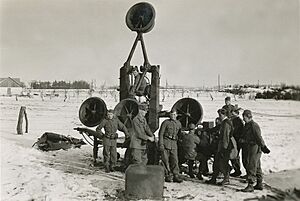Acoustic location facts for kids

Acoustic location is a way to find where an object or a sound is coming from. It uses sound waves to do this. This method works in different places like air, water, or even solid ground.
There are two main ways to use acoustic location:
- Active acoustic location: This is when you create a sound yourself. You then listen for the echo that bounces back from an object. By studying this echo, you can figure out where the object is.
- Passive acoustic location: This is when you simply listen for sounds or vibrations that an object makes on its own. You then analyze these sounds to find the object's location.
When these techniques are used in water, they are called sonar. Both passive sonar (listening) and active sonar (sending out sound and listening for echoes) are used a lot.
Acoustic mirrors and dishes can be used for both types of location. If they use microphones to listen, it's passive. If they use speakers to send out sound, it's active. Often, more than one device is used. This helps to pinpoint the exact location by using a method called triangulation.
How It Was Used in the Past
Military Uses
In the past, especially during World War I and the early parts of World War II, acoustic location was used by the military. Soldiers used it as an air defense tool. They would listen for the noise of enemy aircraft engines to find them.
However, this method became less useful when radar was invented. Radar was much better at finding planes. Still, acoustic methods had one cool advantage: sound could bend around corners and over hills. This meant they could sometimes "see" things that radar couldn't.
Everyday Uses Today
Acoustic location is also used in many everyday situations. For example, it helps scientists find wildlife by listening to their sounds. It can also be used to find the exact spot where a gun was fired.
Images for kids
-
A 3D image of a canyon under the Red Sea. This image was created using echo-sounding from a survey ship.
See also
- Acoustic camera
- 3D sound reconstruction
- 3D sound localization
- Sound localization
- Boomerang
- Multilateration
- Acoustic mirror
- Acoustic wayfinding, the practice of using auditory cues and sound markers to navigate indoor and outdoor spaces
- Animal echolocation, animals emitting sound and listening to the echo in order to locate objects or navigate
- Echo sounding, listening to the echo of sound pulses to measure the distance to the bottom of the sea, a special case of sonar
- Gunfire locator
- Human echolocation, the use of echolocation by blind people
- Human bycatch
- Medical ultrasonography, the use of ultrasound echoes to look inside the body
- Sensory substitution





